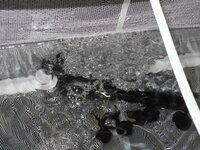I have often thought that our languishing 140 would be ideal for cuttlefish but did not want to go through the hassle and expense of raising new hatchlings. Several weeks ago I spent some time cleaning up the pentagon tank in the dining room but with no real intent. Being cephless for several months (longer than at any time since I have kept them), not finding an animal I was comfortable buying and a post in the availability thread sent me down a path of no return and my 6 cuttle eggs were delivered today from Blue Zoo Aquatics.
I contacted @Bret Grasse MBA for instructions on his soda bottle bubbler but thought my eggs would likely be closer to hatching than the time when it would be helpful. However, when the eggs came, they were still very opaque so I decided they may fare best if tumbled for awhile. I did not have the components on hand so I am experimenting with a net and an air stone. The attached photos and videos are how I spent my day. Suggestions from others who have successfully raised them from this stage would be much appreciated (@Thales, @cuttlegirl ...)
Incubator Attempt 1
First I tried placing the air stone underneath the netting. This was a no go because the net is finer than the bubbles so that air would become trapped underneath and then explode through the netting with enough force to exit the tank.
Incubator Attempt 2
Plain net with air stone placed inside. The weight of the air stone pulling the net caused the eggs to line up along the edge but not circulate. Photos is interesting but not very descriptive

Incubator Attempt 3
I stacked two grids in the net (nets have a post to allow supporting the top grid) and sandwiched the air stone between the grids, placing the eggs on top. The current worked well to move the eggs but I became concerned about abrasion from the nylon grid.

Incubator Attempt 4 (current configuration)
I placed one nylon grid underneath the net and secured it with a zip tie then placed the air stone on edge along the side of the net and tilted the net slightly toward the air stone. This does sweep the eggs up into the circular bubble stream at different points in time. They will circulate for awhile, fall where they are out of the motion and eventually get knocked by another egg back into the stream. I am still a bit concerned with abrasion as the eggs are lifted but the video suggest they don't actually touch the rough surface of the air stone.

Suggestions and comments requested!!!!
I contacted @Bret Grasse MBA for instructions on his soda bottle bubbler but thought my eggs would likely be closer to hatching than the time when it would be helpful. However, when the eggs came, they were still very opaque so I decided they may fare best if tumbled for awhile. I did not have the components on hand so I am experimenting with a net and an air stone. The attached photos and videos are how I spent my day. Suggestions from others who have successfully raised them from this stage would be much appreciated (@Thales, @cuttlegirl ...)
Incubator Attempt 1
First I tried placing the air stone underneath the netting. This was a no go because the net is finer than the bubbles so that air would become trapped underneath and then explode through the netting with enough force to exit the tank.
Incubator Attempt 2
Plain net with air stone placed inside. The weight of the air stone pulling the net caused the eggs to line up along the edge but not circulate. Photos is interesting but not very descriptive

Incubator Attempt 3
I stacked two grids in the net (nets have a post to allow supporting the top grid) and sandwiched the air stone between the grids, placing the eggs on top. The current worked well to move the eggs but I became concerned about abrasion from the nylon grid.

Incubator Attempt 4 (current configuration)
I placed one nylon grid underneath the net and secured it with a zip tie then placed the air stone on edge along the side of the net and tilted the net slightly toward the air stone. This does sweep the eggs up into the circular bubble stream at different points in time. They will circulate for awhile, fall where they are out of the motion and eventually get knocked by another egg back into the stream. I am still a bit concerned with abrasion as the eggs are lifted but the video suggest they don't actually touch the rough surface of the air stone.

Suggestions and comments requested!!!!
Last edited:


